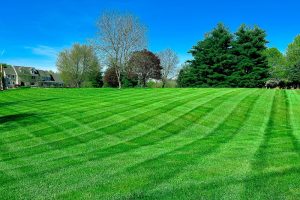 Creating a vibrant, healthy lawn is a rewarding endeavor that enhances the beauty of your home and provides a welcoming space for family and friends. A well-maintained lawn not only improves curb appeal but also contributes to environmental benefits such as erosion control and improved air quality. To help you cultivate a lush green lawn that will be the envy of your neighborhood, we’ve compiled a comprehensive guide outlining six essential steps to follow.
Creating a vibrant, healthy lawn is a rewarding endeavor that enhances the beauty of your home and provides a welcoming space for family and friends. A well-maintained lawn not only improves curb appeal but also contributes to environmental benefits such as erosion control and improved air quality. To help you cultivate a lush green lawn that will be the envy of your neighborhood, we’ve compiled a comprehensive guide outlining six essential steps to follow.
Understanding Your Lawn’s Needs
Before diving into the maintenance process, it’s crucial to understand the specific requirements of your lawn. Different grass types have unique needs based on climate, soil conditions, and usage.
1. Identify Your Grass Type
Knowing whether you have cool-season or warm-season grass is fundamental. Cool-season grasses, such as Kentucky bluegrass and fescue, thrive in the northern regions and prefer fertilization in spring and fall. In contrast, warm-season grasses like Bermuda and Zoysia flourish in southern climates and benefit from fertilization during the summer months.
2. Conduct a Soil Test
A soil test is an invaluable tool that reveals the nutrient composition and pH level of your soil. Most grasses prefer a pH range of 6.0 to 7.0. Testing your soil will help you determine if you need to amend it with lime or sulfur to achieve optimal conditions for nutrient absorption.
Step 1: Mow with Purpose
Mowing is not just about keeping your lawn neat; it plays a significant role in its health.
1. Set the Right Height
Adjust your mower to the appropriate height for your grass type. For cool-season grasses, aim for a height of 3 to 4 inches, while warm-season grasses should be kept at 1 to 2 inches. Taller grass shades the soil, reducing weed growth and promoting deeper root systems.
2. Maintain Sharp Blades
Ensure your mower blades are sharp to make clean cuts. Dull blades can tear grass, leading to increased moisture loss and susceptibility to disease. Regularly sharpening your blades will also improve the efficiency of your mowing.
3. Mow Regularly
Establish a mowing schedule based on the growth rate of your grass. During peak growing seasons, you may need to mow weekly. Avoid cutting more than one-third of the grass height at a time to prevent stress on the plants.
Step 2: Water Wisely
Proper watering is essential for maintaining a healthy lawn, especially during hot summer months.
1. Establish a Watering Schedule
A general rule of thumb is to provide about one inch of water per week, either through rainfall or irrigation. Early morning is the best time to water, as it minimizes evaporation and allows grass blades to dry before evening.
2. Deep Watering Techniques
When watering, aim to saturate the top 4 to 6 inches of soil. This encourages deep root growth, making your lawn more drought-resistant. Use a rain gauge or a simple container to measure the amount of water applied.
3. Adjust for Weather Conditions
During periods of heavy rainfall, reduce your watering frequency. Conversely, during dry spells, increase your watering to ensure your lawn remains healthy and vibrant.
Step 3: Fertilize Effectively
Fertilization is key to providing your lawn with the nutrients it needs to thrive.
1. Choose the Right Fertilizer
Select a fertilizer that matches your grass type and soil conditions. For cool-season grasses, a balanced fertilizer with higher nitrogen content is ideal in spring and fall. Warm-season grasses benefit from a similar approach but require fertilization during their active growth period in summer.
2. Timing is Everything
Apply fertilizer at the right times to maximize its effectiveness. For cool-season grasses, fertilize in early spring and again in late fall. Warm-season grasses should be fertilized in late spring and mid-summer.
3. Organic vs. Synthetic
Consider using organic fertilizers, which improve soil health and microbial activity over time. While synthetic fertilizers provide quick results, they can lead to nutrient runoff and environmental concerns if not applied correctly.
Step 4: Aerate Your Lawn
Aeration is a crucial step in promoting healthy grass growth, especially for lawns that experience heavy foot traffic.
1. Understand the Benefits
Aeration involves perforating the soil with holes to allow air, water, and nutrients to penetrate deeper into the root zone. This process reduces soil compaction and encourages root development.
2. When to Aerate
The best time to aerate your lawn is during the growing season when the grass can recover quickly. For cool-season grasses, aerate in the fall, while warm-season grasses should be aerated in late spring or early summer.
3. Methods of Aeration
You can choose between manual and mechanical aeration methods. Manual aerators are suitable for small areas, while mechanical aerators are more efficient for larger lawns.
Step 5: Control Weeds and Pests
A healthy lawn is your best defense against weeds and pests.
1. Identify Common Weeds
Understanding the types of weeds in your lawn will help you choose the right control methods. Dandelions and crabgrass are common culprits that can be managed with proper lawn care practices.
2. Use Pre-Emergent Herbicides
Applying pre-emergent herbicides in early spring can prevent weed seeds from germinating. Timing is crucial; aim to apply these treatments before the soil temperature reaches 55°F.
3. Spot Treatment for Existing Weeds
For existing weeds, consider using targeted herbicides or hand-pulling. Spot treatments minimize chemical use and reduce environmental impact.
Step 6: Prepare for Seasonal Changes
As seasons change, so do the needs of your lawn.
1. Fall Preparation
In the fall, focus on preparing your lawn for winter. This includes a final fertilization to promote root growth and resilience against cold temperatures. Aerate and overseed any bare patches to ensure a lush lawn come spring.
2. Winter Care
During winter, avoid heavy foot traffic on dormant grass to prevent damage. If snow covers your lawn, resist the urge to clear it, as the snow acts as insulation.
3. Spring Awakening
As spring arrives, perform a thorough cleanup of debris and dead grass. Rake your lawn to remove thatch and prepare it for the growing season ahead.
Achieving a healthy, green lawn requires dedication and knowledge of best practices. By understanding your grass type, mowing effectively, watering wisely, fertilizing appropriately, aerating, controlling weeds, and preparing for seasonal changes, you can cultivate a lawn that not only enhances your home’s beauty but also provides a sustainable environment for your family and community. With these six steps, you’ll be well on your way to enjoying a vibrant lawn that you can be proud of all year round.
We Provide Residential & Commercial Landscaping Services
First Green Landscaping is a locally owned and leading provider of lawn care and landscape maintenance services to homes and businesses in Cincinnati and Northern Kentucky. We provide superior customer service and strive to build long term business relationships with our clients.
> Learn More
Contact us (859-292‐8556) today for a free consultation!
—
 About First Green Commercial Landscaping
About First Green Commercial Landscaping
First Green Commercial Landscaping is a locally owned leading provider of lawn care and landscaping services in the Cincinnati / Northern Kentucky area. We provide superior customer service and strive to build long term business relationships with our clients.
- Lawn Care
- Landscape Maintenance
- Snow Removal
>> Learn More
